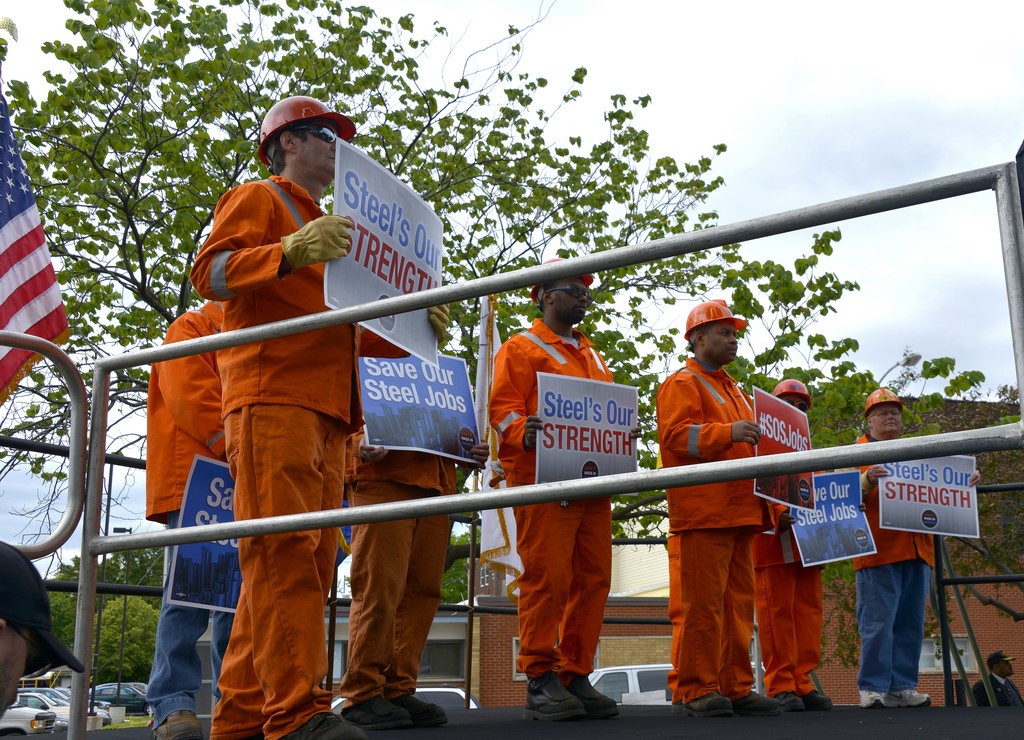
Let’s talks about trade and steel.
Earlier this week Alliance for American Manufacturing (AAM) President Scott Paul gave a virtual presentation on “Understanding Trade Enforcement” for an interactive online workshop hosted by the National Press Foundation.
The presentation focused on key points of trade policy during the Trump administration, including the problem of global steel overcapacity; the Section 232 tariffs and their national security justifications, trade with China and the ‘Phase 1’ deal; the United States, Mexico and Canada Agreement; and trade with the European Union (EU) and Japan.
But let’s focus on steel – and trade with China.
The world had the ability to make a lot of steel: There was the capacity to produce nearly 2.4 billion metric tons of it worldwide last year. That means there’s entirely too much steel being made than what market demand calls for. In fact, global excess capacity figures to be at about 700 million metric tons (MMT) – an absurdly high figure. Most of the overcapacity problem can be traced to China, which has accounted for 75% of global steelmaking growth since 2000. The output of the Chinese steel industry reached a record level in 2018, when it churned out 928 MMT. Through the first 11 months of 2019, China’s steel producers accounted for almost 54% of all raw steel produced in the world. The problem here is that China’s state-owned and state-subsidized steel companies make more steel than necessary because there’s little financial reason to slow production – which ultimately results in massive dumping in the international steel market for minimal cost.
Minimal cost for the Chinese steel industry, that is: Dumped and other unfairly traded steel imports led to approximately 14,500 layoffs in the American steel industry from 2015 to 2016.
Considering all of that, the Section 232 tariffs have played a huge role in the health of the American steel industry. They went up in 2018, when the Trump administration placed a 25% tariff on all steel imports to stabilize the domestic steel sector. They’ve proven crucial over the past few years, as they’ve allowed American steel manufacturers and workers a little breathing room and the ability to invest in the kinds of capital upgrades that will allow them to be competitive in the future. But they haven’t shut off the steel trade, nor were they intended to; U.S. steel imports are still four times greater than exports despite the tariffs.
Earlier this week in response to the global coronavirus pandemic that’s beginning to deeply shake the American economy, AAM sent a letter to Congress urging Representatives and Senators to ‘Focus on Public Health Response, Investments in American-Made Infrastructure, and Supply Chain Vulnerabilities.’ It specifically urges Congress not to attempt to walk back the Section 232 steel tariffs, or the Section 301 tariffs that the United States has leveled directly at China for a raft of unfair trade practices. As outlined above, those 232 tariffs have fortified the American steel industry. And those China 301 tariffs are what set out the trade fight between our two countries, and ultimately resulted in the “Phase 1” deal that President Trump signed with a Chinese counterpart back in January.
Walking back the 301s would give away crucial leverage in future trade talks, and walking back the 232s would leave the steel industry dangerously exposed to the huge stockpiles of subsidized steel that Chinese mills have churned out, right as the coronavirus has the U.S. economy on the brink of calamity.
In the letter AAM President Scott Paul writes:
“We also strongly caution against broad ‘tariff relief’ measures being suggested by a coalition of importers as a benefit to consumers. The Section 301 tariffs on China should be maintained to foster negotiations on a Phase Two trade deal. With nearly all major structural issues left unresolved by the Phase One agreement – including industrial subsidies, overcapacity, state-owned enterprises, predatory investment, currency manipulation and misalignment, cyber intrusions, worker rights, environmental rules, tax policy – it would be counterproductive to lift these tariffs, and to cede valuable negotiating leverage, without securing anything in return. We must strive to secure a deal that is comprehensive, specific, enforceable, and backed by strong and automatic penalties if Beijing fails to live up to its word.”
And while we’re on the subject of China: The “Phase 1” deal that President Trump was crowing about only a few weeks ago hasn’t really been of much help to the U.S. China agreed to increase purchases of U.S. goods by $200 billion over 2017 levels, and the U.S. agreed to reduce some of the tariffs on $112 billion worth of imports from 15 to 7.5 percent … but Phase 1 did nothing to address the fundamental problems inherent with trading with a country like China, that practices “state capitalism.” And will the things Phase 1 did do, like setting purchasing quotas for China, really be enforced?
That’s what it really comes down to: Enforcement. An agreement is only good if its rules are being followed. It wasn’t clear if China was going to live up to its agreements before the coronavirus breakout; it’s even less clear now as the global economy braces for recession.
This is a bread-and-butter issue for AAM. You know we’ll be watching trade in the turbulent days, weeks and months ahead.
